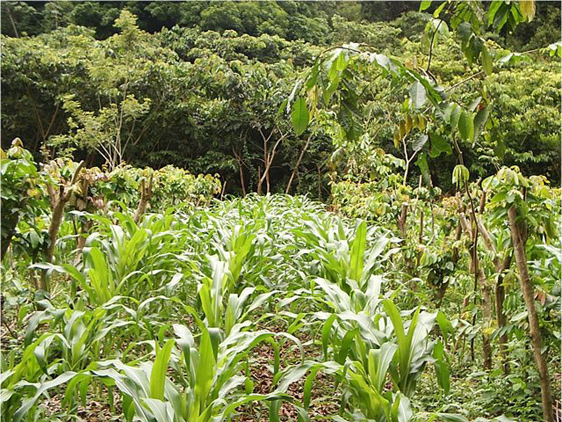
The Genus Inga contains around 300 species in tropical America, which are thought to have all evolved within just the last 2 million years. Artifacts in the shape of Inga seeds pods have been found in Peru and elsewhere dating back thousands of years and the tree is an important part of the local agro-economy. The fruit of many are edible and part of the basic diet of the indigenous pre-Columbian inhabitants of Peru. The tree has been used as a shade tree for coffee, cacao and tea in the past.
Nine Reasons Why Inga is an Essential Part of Successful Alley Cropping:
1. High species diversity and great ecological range
Inga is a huge genus of around 300 species widely distributed throughout lowland and montane regions of humid tropical America. Each locality has its own set of species adapted to the local conditions. Using local species avoids dependence on a single species with the associated problems of pest and diseases.
2. Rapid Growth
Many Inga species are fast growing, light-demanding plants which have the ability to compete successfully with weedy secondary vegetation.
3. Rapid Germination
Inga is easily grown from seeds, with normal germination rates of 95-100%. Given moisture and shade they germinate within a week or two of planting.
4. Tolerance of poor soils
Many Inga species are well adapted to infertile, red acidic soils, such as are found over wide areas of the lowland humid tropics of Amazonia. Such species as I. Edulis and I. Marginata flourish under very low pH conditions, which other legumes cannot tolerate, while other Inga species do well on poorly drained or periodically flooded sites. Plus they are very successful at restoring compacted pasture land, which can then be reclaimed using the alley cropping systems.
5. Improving soil fertility through nitrogen fixation and mycorrhizal activity
All species of Inga so far investigated produce root nodules containing nitrogen fixing bacteria.Crops grown in combination with Inga benefit from the release of nitrogen and also from a sustained release of nutrients from the slowly decomposing leaf mulch. The permanent mulch beneath Inga trees has the effect of causing rooting to be raised up into the surface layers of the soil above the region of aluminium toxicity, as happens in the natural forest. Plus, the mulch reduces the soil surface temperature to the levels found in natural forest. This is key for the germination of crop seeds sown within it.
Inga roots also form associations with mycorrhizal fungi, which probably provide the means by which Inga plants are able to recycle phosphorus which is unavailable to non-mycorrrhizal plant species on the same soils.
6. Shading by Inga controls weeds
All Inga species have essentially the same branching pattern which, when growing in an open situation, gives rise to the characteristic broad umbrella shaped crown. This shape makes Inga an excellent shade tree for such crops as coffee, cacao and tea, which require a partial shade. It is also the reason why they are important for alley cropping as they are an effective weed control and good for regenerating abandoned pasture. Some species combine very fast growth with very large leaves. The leaves which fall throughout the year are relatively slow to decompose and soon form a long lasting mulch below the tree and this, combined with the shading effect of the Inga crown, soon depresses the growth of all vegetation below the trees and within a year or two eliminates it, producing a clean forest soil which can then be brought into productive use by the local farmers.
7. Fuelwood
Throughout Central and western South America, where a large proportion of the population still rely on wood for cooking, Inga species are usually cited as a preferred fuelwood. The reasons for this are several; its fast growth, tolerance of coppicing (vital to the alley cropping system) and a wood which burns well without producing a lot of smoke. It is likely that Inga would also be good for charcoal production.
8. Biological Interactions
All Inga species have small nectar producing glands on the leaves. These attract a wide range of insects to the plant, especially ants. The direct effect of these visiting insects is that they protect the Inga plant against herbivores. However, there is also an indirect benefit in that the visiting insects may also parasitize pests living on crop species grown among the trees in the alleys. In this way, Inga has been successfully used as a nurse crop for other timber species such as Mahogany (Swietenia macrophylla) which is normally heavily parasitized by a shoot borer, Hypsipla.
9. Edible Fruit with Many Seeds
All species of Inga have edible fruit and many are protected and cultivated for this reason. At certain times of the year the fruit forms an item of commerce in the local markets so their cultivation can provide a useful source of additional income for farmers and peasants. Each country in Central America and the Andean region has a unique group of species with edible fruit extending from the lowlands up to 10,000 feet in altitude.
